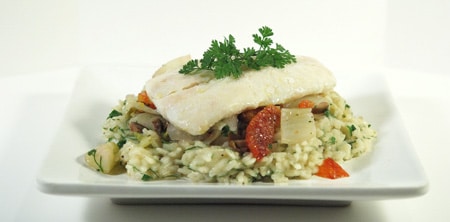
Halibut is a delicately flavored fish that happens to have a burly, meaty texture — this is why it works as well as fish and chips as it does in this delicate recipe, where you gently poach the fish in olive oil that is infused with chervil or fennel fronds.
The best way to make this dish is with a vacuum sealer and a big pot of hot water. I call it “ghetto sous vide,” because you get the same basic effect but without the control you have with a real sous vide machine, which can keep hot water at a precise temperature forever.
If you don’t have a vacuum sealer (if you are a hunter, you really ought to, as it keeps food far longer than in any other method), you can submerge the halibut in olive oil in a pot instead. It requires more oil, however, and it will be fishy afterwards. You can strain it through cheesecloth and use it to fry more fish in, but that’s about it.
Chervil is a beautiful, lacy herb that grows in cool weather. It has a delicate anise flavor and is wonderful with white fish. If you cannot find it, use chopped fronds from fennel.
If you can’t get halibut, use another white fish, such as California white seabass, striped bass, a big walleye, redfish, grouper, snapper or tautog.
Serves 4
- 1 1/2 to 2 pounds skinless halibut fillets or steaks
- Salt
- 1/4 cup olive oil (or more to submerge)
- 1/4 cup (loosely packed) chervil leaves or chopped fennel fronds
- More chervil or fennel for garnish
- Juice of 1 lemon
- Black pepper
- Salt the halibut pieces well and set aside.
- If you are using a vacuum sealer, fill a stockpot or other large pot two-thirds full of water and get it hot. Don’t let it boil.
- By the time your water is nearly done — you want steaming, but no bubbling, about 160 degrees — you will want to seal up your halibut.
- Place the fish in the bag in one layer. This is important, because if you have them in more than one layer they will not cook correctly. You may need two bags. Place some chervil on either side of the fish in the bag and pour in olive oil. Seal gently and carefully, as you don’t want oil shooting up through the bag.
- When the water temperature is 160 degrees, turn off the heat and drop the fish bags in. Don’t cover the pot. Wait 10-15 minutes, depending on how thick the fish is. This is a very gentle cooking method, so you have a lot of leeway in cooking times here.
- If you are oil-poaching in a pot without a vacuum sealer, pour at least 2 cups of olive oil into a heavy pot and add the chervil or fennel. Turn the heat on low and wait 10 minutes.
- Pat the halibut dry and slip them into the pot. Make sure the oil is cool enough that your fish does not fry. Less than 200 degrees. You don’t want to see any bubbles. You might need to turn off the heat from time to time. Cook like this for 10-15 minutes, again depending on the width of your halibut.
- The tricky part of this dish is presentation. Your halibut will want to fall apart, so you need to be careful taking it out of the bag or pot. Lay it on a seafood risotto or polenta.
- Spread a little of the cooking oil over, hit the fish with a little lemon juice and some black pepper, then garnish with the extra chervil.
- Serve with a big white wine, like a California Viognier or Chardonnay.